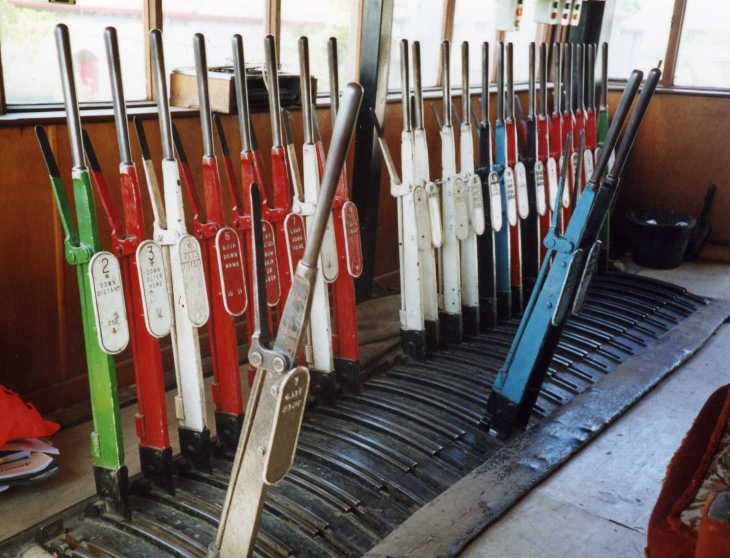|
Bulford Railway Station
Bulford railway station served the village of Bulford in Wiltshire, England, between 1906 and 1963. Extension The line between and had already opened in 1902, being operated by the London and South Western Railway. In May of that year, the War Department requested that the line be extended from its present terminus to the recently opened Bulford Camp. A new light railway order, for the Amesbury & Military Camp Light Railway (Bulford Extension) was confirmed on 10 January 1903. The War Department had an agreement with the railway company to provide financial assistance for the building of the extension. The extension was built by the LSWR's own staff. Work on the extension began in 1904. Design Bulford was the terminus of the public passenger service; trains which continued beyond it were exclusively for military purposes. It had a single concrete-faced platform on the down side of the line, with a run-around loop and a substantial station building built from brick and timber ... [...More Info...] [...Related Items...] OR: [Wikipedia] [Google] [Baidu] |
Bulford
Bulford is a village and civil parish in Wiltshire, England, close to Salisbury Plain. The village is close to Durrington and about north of the town of Amesbury. The Bulford Camp army base is separate from the village but within the parish. The Salisbury Avon forms the western boundary of the parish, and the village is near the confluence of the Nine Mile River with the Avon. The Bulford Kiwi – a large chalk representation of a kiwi – is on a hill above the village. History Evidence of occupation of the area in the late Neolithic era is provided by many round barrows on the downs. A Bronze Age boundary ditch is in the northeast of the parish. The 1086 Domesday Book recorded 39 households at Bulford, within an estate of Amesbury Abbey. The name is derived from the Old English ''bulut ieg ford'' meaning 'ragged robin island ford'. It is recorded in the Wiltshire Charter Rolls of 1199 as ''Bultiford'' and as ''Bultesforda'' in 1270. It is then recorded as ''Bultefo ... [...More Info...] [...Related Items...] OR: [Wikipedia] [Google] [Baidu] |
Amesbury And Military Camp Light Railway
The Amesbury and Military Camp Light Railway (also known as the Bulford Camp Railway) was a branch line in Wiltshire, England, constructed under a light railway order dated 24 September 1898. It was opened for military traffic from Amesbury to the east-facing Newton Tony Junction (on the London and South Western Railway main line from Andover to Salisbury, part of the West of England line) on 1 October 1901. A west-facing junction, Amesbury Junction, where the branch burrowed under the main line, opened on 2 June 1902. The line closed in 1963. Previous proposals Although the line did not open until the early 1900s, various other proposals had been put forward, but none had succeeded in being built. Before the Bulford Camp branch opened, all nearby railway routes had skirted Salisbury Plain, but none led through it.Harding, Peter. ''The Bulford Branch Line''. Binfield Printers, 1991, pp.4-5 Bristol and London & South Western Junction Railway This was a proposal by the London and ... [...More Info...] [...Related Items...] OR: [Wikipedia] [Google] [Baidu] |
London And South Western Railway
The London and South Western Railway (LSWR, sometimes written L&SWR) was a railway company in England from 1838 to 1922. Originating as the London and Southampton Railway, its network extended to Dorchester and Weymouth, to Salisbury, Exeter and Plymouth, and to Padstow, Ilfracombe and Bude. It developed a network of routes in Hampshire, Surrey and Berkshire, including Portsmouth and Reading. The LSWR became famous for its express passenger trains to Bournemouth and Weymouth, and to Devon and Cornwall. Nearer London it developed a dense suburban network and was pioneering in the introduction of a widespread suburban electrified passenger network. It was the prime mover of the development of Southampton Docks, which became an important ocean terminal as well as a harbour for cross channel services and for Isle of Wight ferries. Although the LSWR's area of influence was not the home of large-scale heavy industry, the transport goods and mineral traffic was a major activity, a ... [...More Info...] [...Related Items...] OR: [Wikipedia] [Google] [Baidu] |
War Department (United Kingdom)
The War Department was the United Kingdom government department responsible for the supply of equipment to the armed forces of the United Kingdom and the pursuance of military activity. In 1857, it became the War Office. Within the War Office, the name 'War Department' remained in use to describe the military transport services of the War Department Fleet and the War Department Railways. History In 1794, the position of Secretary of State for War was created. The Secretary's department was at first unofficially known as the War Department. Colonial affairs were later added and it became the Colony Department. After the outbreak of war with revolutionary France it became Colony and War Department and on the restoration of peace in 1815 the Colonial Department. In February 1855, the offices of the Secretary of State for War, and Secretary at War were merged and the new department and became the War Department once again until 1857 when it became the War Office. In 1964, the depar ... [...More Info...] [...Related Items...] OR: [Wikipedia] [Google] [Baidu] |
Bulford Camp
Bulford Camp is a military camp on Salisbury Plain in Wiltshire, England. Established in 1897, the site continues in use as a large British Army base. The camp is close to the village of Bulford and is about northeast of the town of Amesbury. The camp forms part of the Tidworth, Netheravon and Bulford (TidNBul) Garrison. History The camp was built as a mixture of tents and huts in 1897. The section called Sling Camp was occupied by soldiers of the New Zealand Expeditionary Force during the First World War. At the end of the war, the overcrowded camp was the site of the Battle of Bulford, when New Zealand troops staged a brief mutiny. Later, New Zealanders awaiting demobilization left their mark by creating the Bulford Kiwi, a large chalk figure on the hillside overlooking the camp. Permanent barracks were built during the inter-war years: the current names were applied in 1931. Carter Barracks, a hutted camp north of Bulford Droveway, beyond the northern boundary of the present ... [...More Info...] [...Related Items...] OR: [Wikipedia] [Google] [Baidu] |
Ground Frame
Mechanical railway signalling installations rely on lever frames for their operation to interlock the signals, track locks and points to allow the safe operation of trains in the area the signals control. Usually located in the signal box, the levers are operated either by the signalman or the pointsman. The world's largest lever frame is believed to have been in the Spencer Street No.1 signal box in Melbourne, Australia, which had 191 levers, but was decommissioned in 2008. The largest, currently operational, lever frame is located at Severn Bridge Junction in Shrewsbury, England, and has 180 levers; although most of them have now been taken out of use. Overview The lever frame is located in the signal box, which can be a building at ground level or a tower, separated from or connected to an existing station building. Early lever frames were also built as ''ground frames'' next to the track, without any form of shelter and were usually operated by traincrew and not per ... [...More Info...] [...Related Items...] OR: [Wikipedia] [Google] [Baidu] |
Property Services Agency
The Property Services Agency (PSA) was an agency of the United Kingdom government, in existence from 1972 to 1993. Its role was to “provide, manage, maintain, and furnish the property used by the government, including defence establishments, offices, courts, research laboratories, training centres and land”. Early history The PSA had its antecedents in the Ministry of Works and earlier departments dating back to the Office of Works. It was created as an autonomous agency in 1972 after the Ministry of Works had been absorbed into the Department of the Environment. First decade, 1972-1981 The agency had the job of providing, equipping and maintaining a wide range of buildings and installations for government departments, and the armed services, as well as other bodies. It held and managed much of the government's civil estate, including government offices and establishments all over the United Kingdom as well as the diplomatic estate abroad. It managed Ministry of Defence pr ... [...More Info...] [...Related Items...] OR: [Wikipedia] [Google] [Baidu] |
Bulford Camp Railway
The Amesbury and Military Camp Light Railway (also known as the Bulford Camp Railway) was a branch line in Wiltshire, England, constructed under a Light Railways Act 1896, light railway order dated 24 September 1898. It was opened for military traffic from Amesbury to the east-facing Newton Tony Junction (on the London and South Western Railway main line from Andover, Hampshire, Andover to Salisbury, part of the West of England line) on 1 October 1901. A west-facing junction, Amesbury Junction, where the branch burrowed under the main line, opened on 2 June 1902. The line closed in 1963. Previous proposals Although the line did not open until the early 1900s, various other proposals had been put forward, but none had succeeded in being built. Before the Bulford Camp branch opened, all nearby railway routes had skirted Salisbury Plain, but none led through it.Harding, Peter. ''The Bulford Branch Line''. Binfield Printers, 1991, pp.4-5 Bristol and London & South Western Junction Ra ... [...More Info...] [...Related Items...] OR: [Wikipedia] [Google] [Baidu] |
Railway Stations In Great Britain Opened In 1906
Rail transport (also known as train transport) is a means of transport that transfers passengers and goods on wheeled vehicles running on rails, which are incorporated in tracks. In contrast to road transport, where the vehicles run on a prepared flat surface, rail vehicles (rolling stock) are directionally guided by the tracks on which they run. Tracks usually consist of steel rails, installed on sleepers (ties) set in ballast, on which the rolling stock, usually fitted with metal wheels, moves. Other variations are also possible, such as "slab track", in which the rails are fastened to a concrete foundation resting on a prepared subsurface. Rolling stock in a rail transport system generally encounters lower frictional resistance than rubber-tyred road vehicles, so passenger and freight cars (carriages and wagons) can be coupled into longer trains. The operation is carried out by a railway company, providing transport between train stations or freight customer faciliti ... [...More Info...] [...Related Items...] OR: [Wikipedia] [Google] [Baidu] |
Railway Stations In Great Britain Closed In 1952
Rail transport (also known as train transport) is a means of transport that transfers passengers and goods on wheeled vehicles running on rails, which are incorporated in Track (rail transport), tracks. In contrast to road transport, where the vehicles run on a prepared flat surface, rail vehicles (rolling stock) are directionally guided by the tracks on which they run. Tracks usually consist of steel rails, installed on Railroad tie, sleepers (ties) set in track ballast, ballast, on which the rolling stock, usually fitted with metal wheels, moves. Other variations are also possible, such as "slab track", in which the rails are fastened to a concrete foundation resting on a prepared subsurface. Rolling stock in a rail transport system generally encounters lower friction, frictional resistance than rubber-tyred road vehicles, so passenger and freight cars (carriages and wagons) can be coupled into longer trains. The rail transport operations, operation is carried out by a ... [...More Info...] [...Related Items...] OR: [Wikipedia] [Google] [Baidu] |



